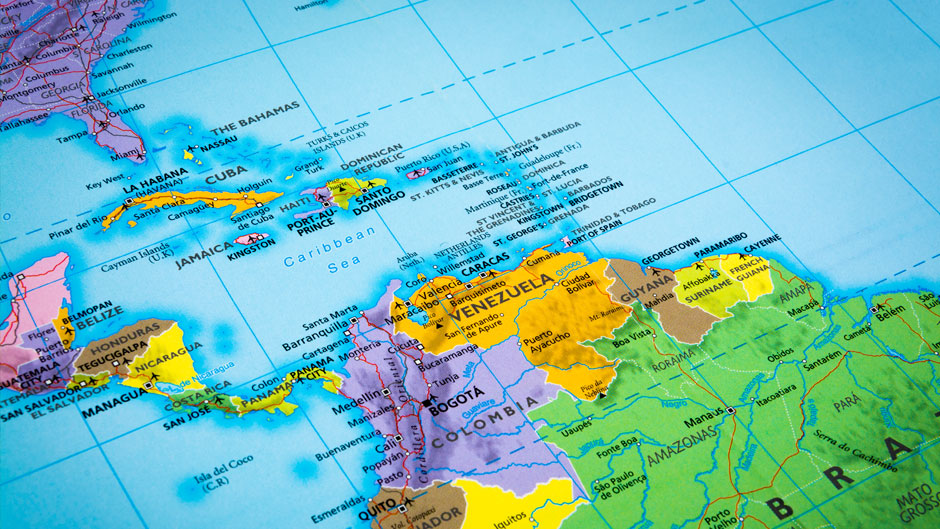Economics professors Alex Horenstein and Michael Connolly both highlighted the tremendous increase in Chinese influence in the Latin American and Caribbean region over the past two decades—achieved as the United States has continued its historic stance of paying scant attention to its southern neighbors.
“China’s economic and strategic reasons—the region is geographically close to the U.S. and provides multiple votes at international organizations like the UN—are clear, and it’s obvious they would do this,” said Horenstein, an assistant professor in the University of Miami Patti and Allan Herbert Business School. “What surprises me the most is that the U.S., with its sophisticated foreign policy design, did not see this happening. Maybe this is what is going to make the U.S. pay more attention to Latin America.”
Through complementary trading relationships and soft diplomacy, China has moved consistently in recent years to fill the void left by the U.S., noted Horenstein, who is originally from Argentina.
That soft diplomacy has been evident most recently, he said, during the pandemic. While the U.S. was blocking sales of masks, surgical gloves, and other materials to the region to serve its own domestic use, China was sending planes with those materials to Latin America and the Caribbean, according to Horenstein.
“Latin America simply has not been of interest for the U.S, at least not economically,” he said, noting that humanitarian aid has remained relatively the same for the past three decades and has dropped continually since 2012 following the earthquake in Haiti. Historic disinterest shifted to disdain on the part of the previous Trump administration, according to media reports.
Additionally, Horenstein stated that “while the U.S has overall been a force of good in the world fighting against tyranny, many interventions in the region have not always been coherent with the greater good.”
Many in the region, he indicated, remember that the U.S. backed authoritarian regimes—not democratic ones—during its decades-long Cold War conflict with the Soviet Union. Those perceptions have tarnished the U.S.’s reputation and contributed to the void—one that China has exploited to tremendous advantage, he explained.
Horenstein contrasted the decades of Cold War tensions that resulted in tragic civil strife and economic paralysis with the emerging dynamic—where competition between the U.S. and China is at the level of trade—that offers opportunities for a mutually beneficial relationship between the U.S. and its southern neighbors.
Opening trade is the key, according to Horenstein. He pointed out that 20 years ago nearly every country in the region traded more with the United States than it did with China, and now China is a more relevant trade partner for almost all South American countries.
“More than any assistance, what would be of real help for Latin America is to just remove the trade barriers and let them trade,” Horenstein declared.
Despite being poor, the region’s countries have a lot of commodities that are used in U.S. industries, he explained, but trade has been blocked through “frictions, quotas, and barriers to trade imposed by the rich countries in the western world.”
China needs the region for its raw materials and markets to sell its manufactured goods and doesn’t need—or want—an industrialized Latin America, he explained, adding that this scenario is “risky” for the region.
“So, while China has taken tremendous advantage of creating complementary markets, maybe by helping Latin American and Caribbean countries industrialize—as it has done with Mexico—the U.S. can counteract China’s influence and benefit everybody,” Horenstein said.
A finance and development specialist, Connolly said that any assistance to the region must bypass the government channels that have historically syphoned off aid for their interests and uses.
“Aid should never be channeled through federal authorities because very little ever reaches the needed areas,” he said. “Better to channel targeted assistance to health and education through local hospitals and schools.”
Connolly, who has taught and lectured throughout Latin America, said assistance should be targeted and delivered by U.S. operatives alongside local operatives: For instance, COVID-19 vaccination sites administered jointly by the U.S. Agency for International Development and regional and municipal authorities.
“It is tilting at windmills to think we can rectify the fundamental causes of poverty and emigration, especially in Central America where corruption is omnipresent and the rule of law not applied de facto,” he added.
In addition to health, he recommended that assistance target education and, again, that all aid be in-kind or delivered in-person, such as U.S.-sponsored teachers dispatched to strengthen literacy and education of the rural poor. “Money transfers to government entities will just be spent on government politicians, administrators, and showy programs, if not embezzled,” he added.
Connolly, too, emphasized the value of trade to advance mutual U.S. and regional interests: “We simply should be competitive in free trade and targeted aid with China,” he said.
“You bolster economies and spur development through free trade areas and free trade zones, such as the U.S.-Mexico-Canada Agreement and Central American Free Trade Agreement. Trade, not aid, bolsters economies and spurs development,” Connolly added. “The engine of growth is human capital, i.e. education, so support focused on that helps in the long run.”

